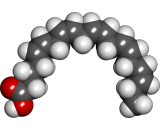Eicosapentaenoic Acid (EPA)
Icosapentaenoic Acid; Timnodonic Acid

| SPN | B625 |
| Wiki | EPA |
| CAS | 10417-94-4 |
Eicosapentaenoic acid is an omega-3 fatty acid. In physiological literature, it is given the name 20:5(n-3). In chemical structure, EPA is a carboxylic acid with a 20-carbon chain and five cis double bonds; the first double bond is located at the third carbon from the omega end. EPA is a polyunsaturated fatty acid (PUFA) that acts as a precursor for prostaglandin-3 (which inhibits platelet aggregation), thromboxane-3, and leukotriene-5 groups (all eicosanoids). It is obtained in the human diet by eating oily fish or fish oil, e.g. cod liver, herring, mackerel, salmon, menhaden and sardine, and various types of edible seaweed. It is also found in human breast milk. However, fish do not naturally produce EPA, but obtain it from the algae they consume. It is available to humans from some non-animal sources (e.g. commercially, from microalgae).
